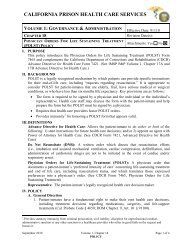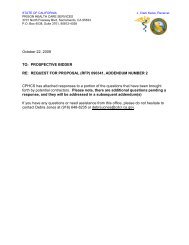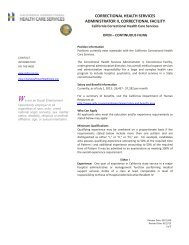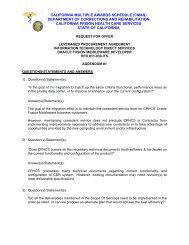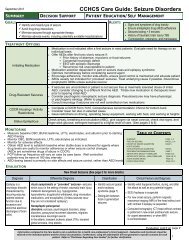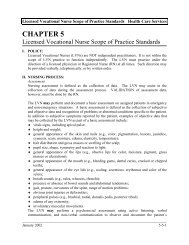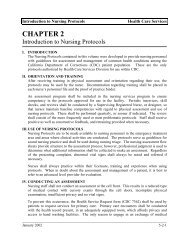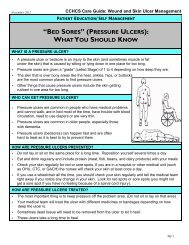Mule Creek State Prison Medical Inspection Results - California ...
Mule Creek State Prison Medical Inspection Results - California ...
Mule Creek State Prison Medical Inspection Results - California ...
Create successful ePaper yourself
Turn your PDF publications into a flip-book with our unique Google optimized e-Paper software.
MULE CREEK STATE PRISONMEDICAL INSPECTION RESULTSBUREAU OF AUDITS AND INVESTIGATIONSOFFICE OF THEINSPECTOR GENERALDAVID R. SHAWINSPECTOR GENERALSTATE OF CALIFORNIASeptember 2010
ContentsExecutive Summary ......................................................................................… 1Introduction …................................................................................................… 3Background …....................................................................................… 3About the Institution …......................................................................… 4Objectives, Scope, and Methodology ….............................................. 4<strong>Medical</strong> <strong>Inspection</strong> <strong>Results</strong> ….......................................................................… 7<strong>California</strong> <strong>Prison</strong> Health Care ReceivershipCorporation's Response …............................................................................. 28
Executive SummaryAn April 2001 class action lawsuit filed by inmates represented by the <strong>Prison</strong> Law Office alleged thatthe state provided constitutionally inadequate medical care at <strong>California</strong> state prisons in violation ofinmates’ constitutional rights. And, in October 2005, the U.S. Northern District Court of <strong>California</strong>declared that <strong>California</strong>’s delivery system for prison medical care was “broken beyond repair” and stillnot meeting constitutional standards. As a result, the federal court imposed a receivership to raise thedelivery of medical care to constitutional standards. To evaluate and monitor the progress of medicalcare delivery to inmates, the receiver requested, and the Office of the Inspector General (OIG) agreed,to establish an objective, clinically appropriate, and metric-oriented medical program to annuallyinspect the delivery of medical care at each state prison.OverallScore74.5%In April 2010, we inspected <strong>Mule</strong> <strong>Creek</strong> <strong>State</strong> <strong>Prison</strong> (MCSP). Our medicalinspection encompassed 18 components of medical delivery and comprised 133questions. The questions are weighted based on their importance to the deliveryof medical care to inmates. MCSP received 74.5 percent of the total weightedpoints possible.The following summary table lists the components we inspected in order of importance (highest tolowest), with the institution’s score and the definitions of each inspection component. The detailedmedical inspection results, with the questions for each component, begin on page 7 of this report.While we are committed to helping each institution achieve a higher level of medical care, it is not ourintent to determine the percentage score needed by an institution to meet constitutional standards—thatis a legal matter for the federal court to determine.Executive Summary TableComponentWeighted Score DefinitionChronic Care 69.8% Examines how well the prison provided care and medication to inmates with specificchronic care conditions, which are those that affect (or have the potential to affect) aninmate's functioning and long-term prognosis for more than six months. Our inspection testsanticoagulation therapy and the following chronic care conditions: asthma, diabetes, HIV(Human Immunodeficiency Virus), and hypertension.Clinical Services 68.7% Evaluates the inmate's access to primary health care services and focuses on inmates whorecently received services from any of the prison's facility or administrative segregation unitclinics. This component evaluates sick call processes (doctor or nurse line), medicationmanagement, and nursing.Health Screening 81.0% Focuses on the prison's process for screening new inmates upon arrival to the institution forhealth care conditions that require treatment and monitoring, as well as ensuring inmates'continuity of care.Specialty Services 75.8% Focuses on the prison's process for approving, denying, and scheduling services that areoutside the specialties of the prison's medical staff. Common examples of these servicesinclude physical therapy, oncology services, podiatry consultations, and neurology services.Urgent Services 74.6% Addresses the care provided by the institution to inmates before and after they were sent to acommunity hospital.Emergency Services 64.0% Examines how well the prison responded to medical emergencies. Specifically, we focusedon "man down" or "woman down" situations. Further, questions determine the adequacy ofmedical and staff response to a "man down" or "woman down" emergency drill.Bureau of Audits and Investigations Page 1Office of the Inspector General<strong>State</strong> of <strong>California</strong>
ComponentWeighted Score DefinitionPrenatal Care/Childbirth/Post-deliveryN/AFocuses on the prenatal and post-delivery medical care provided to pregnant inmates. Thiscomponent is not applicable at men's institutions.Diagnostic Services 68.1% Addresses the timeliness of radiology (x-ray) and laboratory services and whether the prisonfollowed up on clinically significant results.Access to Health CareInformation72.5% Addresses the prison's effectiveness in filing, storing, and retrieving medical records andmedical-related information.Outpatient Housing Unit N/A Determines whether the prison followed department policies and procedures when placinginmates in the outpatient housing unit. This component also evaluates whether theplacement provided the inmate with adequate care and whether the physician's planaddressed the placement diagnosis.Internal Reviews 82.5% Focuses on the activities of the prison's Quality Management Committee (QMC) andEmergency <strong>Medical</strong> Response Review Committee (EMRRC). The component also evaluatesthe timeliness inmates' medical appeals filed, and the prison's use of inmate death reviews.Inmate Transfers 68.4% Focuses on inmates pending transfer to determine whether the sending institutiondocumented medication and medical conditions to assist the receiving institution inproviding continuity of care.Clinic Operations 100.0% Addresses the general operational aspects of the prison's facility clinics. Generally, thequestions in this component relate to the overall cleanliness of the clinics, privacy affordedto inmates during nonemergency visits, use of priority ducats (slip of paper the inmatecarries for scheduled medical appointments), and availability of health care request forms.Preventive Services 40.0% Focuses on inmate cancer screening, tuberculosis evaluation, and influenza immunizations.Pharmacy Services 93.1% Addresses whether the prison's pharmacy complies with various operational policies, suchas conducting periodic inventory counts, maintaining the currency of medications in itscrash carts and after-hours medication supplies, and having valid permits. In addition, thiscomponent also addresses whether the pharmacy has an effective process for screeningmedication orders for potential adverse reactions/interactions.Other Services 85.0% Examines additional areas that are not captured in the other components. The areasevaluated in this component include the prison's provision of therapeutic diets, its handlingof inmates who display poor hygiene, and the availability of the current version of thedepartment's Inmate <strong>Medical</strong> Services Policies and Procedures.Inmate Hunger Strikes 81.6% Examines medical staff's monitoring of inmates participating in hunger strikes lasting longerthan three days.Chemical AgentContraindicationsStaffing Levels andTraining100.0% Addresses the prison's process of handling inmates who may be predisposed to an adverseoutcome from calculated uses of force (cell extractions) involving Oleoresin Capsicum(OC), which is commonly referred to as "pepper spray." For example, this might occur if theinmate has asthma.100.0% Examines the prison's medical staffing levels and training provided.Nursing Policy 88.6% Determines whether the prison maintains written policies and procedures for the safe andeffective provision of quality nursing care. The questions in this component also determinewhether nursing staff review their duty statements and whether supervisors periodicallyreview the work of nurses to ensure they properly follow established nursing protocols.Overall Score 74.5%Bureau of Audits and Investigations Page 2Office of the Inspector General<strong>State</strong> of <strong>California</strong>
IntroductionUnder the authority of <strong>California</strong> Penal Code section 6126, which assigns the Office of the InspectorGeneral (OIG) responsibility for oversight of the <strong>California</strong> Department of Corrections andRehabilitation, and at the request of the federal receiver, the OIG developed a comprehensiveinspection program to evaluate the delivery of medical care at each of the <strong>California</strong> Department ofCorrections and Rehabilitation’s 33 adult prisons.In April 2010, we inspected <strong>Mule</strong> <strong>Creek</strong> <strong>State</strong> <strong>Prison</strong> (MCSP). Our medical inspection encompassed 18components of medical delivery and comprised 133 questions. To help readers understand the medicalrisk associated with certain components of medical delivery—which pose a greater risk to an inmatepatient—wedeveloped a weighting system and assigned points to each question. Consequently, weassigned more total points to more critical components, such as chronic care, clinical services, andhealth screening. We assigned fewer total points to less critical components, such as inmate hungerstrikes, staffing levels and training, and chemical agent contraindications. (For a detailed description ofthe weighting system, see Objectives, Scope, and Methodology on the next page.)BackgroundIn April 2001, inmates represented by the <strong>Prison</strong> Law Office filed a class action lawsuit, known asPlata v. Schwarzenegger. The lawsuit alleged that the state provided constitutionally inadequatemedical care at <strong>California</strong> state prisons in violation of inmates’ constitutional rights. In June 2002, theparties entered into a Stipulation for Injunctive Relief, and the state agreed to implement over severalyears comprehensive new medical care policies and procedures at all institutions.Nevertheless, the U.S. Northern District Court of <strong>California</strong> declared in October 2005 that <strong>California</strong>’sdelivery system for prison medical care was “broken beyond repair” and still not meeting constitutionalstandards. Thus, the federal court imposed a receivership to raise the delivery of medical care toconstitutional standards. In essence, the court ordered the receiver to manage the state’s delivery ofmedical care and restructure day-to-day operations to develop and sustain a system that providesconstitutionally adequate medical care to inmates. The court stated that it would remove the receiverand return control to the state once the system is stable and provides for constitutionally adequatemedical care.To evaluate and monitor the progress of medical care delivery to inmates, the receiver requested thatthe OIG establish an objective, clinically appropriate, and metric-oriented medical inspection program.Toward that end, the Inspector General agreed to inspect each state prison annually. We are committedto helping each institution achieve a higher level of medical care, but it is up to the federal court todetermine the percentage score necessary for an institution to meet constitutional standards.Bureau of Audits and Investigations Page 3Office of the Inspector General<strong>State</strong> of <strong>California</strong>
About the InstitutionThe primary mission of <strong>Mule</strong> <strong>Creek</strong> <strong>State</strong> <strong>Prison</strong> (MCSP) is to provide a safe, secure and disciplinedenvironment for criminal offenders within the <strong>California</strong> Department of Corrections and Rehabilitation,in accordance with state and federal law. As of August 18, 2010, the <strong>California</strong> Department ofCorrections and Rehabilitation reported that MCSP had custody over 3,749 male inmates, of which3,459 are Level III and Level IV inmates. MCSP operates five medical clinics where staff handle nonurgentrequests for medical services. MCSP also treats inmates needing urgent or emergency care in itstriage and treatment area (TTA). When processing inmate requests for clinical services, MCSP followsa pilot program that in some ways differ from CDCR's statewide policies. The <strong>Prison</strong> Law Office andreceiver are aware of the different procedures used by MCSP. Therefore, some of our questions in theClinical Services component were not applicable to a small number of sample items. According toinformation provided by the institution, MCSP's vacancy rate among licensed medical managers,primary care providers, supervisors, and rank and file nurses is 4.2 percent.Leonard Heffner, M.D., serves as the prison's chief executive officer over health care services, andScott Heatley, M.D., serves as the prison's chief medical officer.Objectives, Scope, and MethodologyIn designing the medical inspection program, we reviewed the <strong>California</strong> Department of Correctionsand Rehabilitation’s policies and procedures, relevant court orders, guidelines developed by thedepartment’s Quality <strong>Medical</strong> Assurance Team, and guidance developed by the American CorrectionalAssociation. We also reviewed professional literature on correctional medical care, consulted withclinical experts, and met with stakeholders from the court, the receiver’s office, the department, and the<strong>Prison</strong> Law Office to discuss the nature and scope of the inspection program. Based on input from thesestakeholders, we developed a medical inspection program that evaluates medical care delivery. Withineach of 20 components, we created “yes” or “no” questions designed to gauge performance.To make the inspection results meaningful to both a medical expert and a lay reader, we worked withclinical experts to create a weighting system that factors the relative importance of each componentcompared to other components. Further, the program considers the relative importance of each questionwithin a component to the other questions in that component. This weighting ensures that more criticalcomponents—such as those that pose the greatest medical risk to the inmate-patient—are given moreweight compared to those considered less serious. For example, we assign a high number of possiblepoints to the chronic care component because we consider this the most serious of all the components.We assign proportionately fewer points to all other components.Each inspection question is weighted and scored. The score is derived from the percentage of “yes”answers for each question from all items sampled. We then multiply the percentage of “yes” answerswithin a given question by the question’s weight to arrive at a score. The following example shows howthis scoring system works.Bureau of Audits and Investigations Page 4Office of the Inspector General<strong>State</strong> of <strong>California</strong>
Example Question: Institution XAnswersWeighting PointsYes No Yes + No Yes % Possible Received Score % N/A UnkIs the clinical history adequate? 40 10 50 80% 20 16 80.0% 0 0If the institution receives 40 “yes” answers and 10 “no” answers, the percentage of “yes” answers tothis question equals 80 percent. We calculate the number of points the institution would receive bymultiplying the “yes” percent of 80 by the number of possible points for this question, which is 20, toarrive at 16 points.To arrive at the total score, we add the points received for each question and then for each programcomponent. Finally, we calculate the institution’s overall score by dividing the sum of the pointsreceived by the sum of the points possible. We do not include in the institution’s overall score theweight for questions that are not applicable or, in some cases, where a lack of documentation wouldresult in numerous “no” answers for one deviation from policy (unknown). For instance, an institutionmay not be able to provide documentation that its Emergency <strong>Medical</strong> Response Review Committeemet for a particular month. Therefore, when we evaluate whether meeting minutes document monthlymeetings for a particular month, the institution would receive a “no” answer for that question.However, when we evaluate whether the meeting minutes document the warden’s attendance at themeeting, the answer would be “unknown” so that the institution’s score is not penalized twice for thesame reason, not documenting the meeting.To evaluate the institution’s delivery of medical care, we obtained various electronic data filesmaintained by the institution for inmate medical scheduling and tracking, pharmacy, and census data.We used these electronic data files only to identify random samples of inmates receiving or requiringspecific medical services. We then reviewed the medical file for each inmate in our sample. We did notrely on the medical care information contained in these electronic data files.Our inspection program assumes that if a prison's medical staff does not document an event in aninmate's unit health record, the event in question did not happen. If an inmate's record does not showthat the inmate received his medications on a specified date, for example, we assume that the inmatedid not receive the medications. While it is possible that the inmate received his medications and thestaff neglected to document the event, our program cannot assume that appropriate care was provided.Our medical inspection at MCSP encompassed 18 of the 20 components of medical delivery. Two ofthe components were not applicable during the period inspected. In total, we reviewed 170 inmatemedical files, which are referred to as unit health records. In addition, we reviewed staffing levelreports, medical appeals summaries, nursing policies and procedures, summaries of medical drills andemergencies, minutes from Quality Management Committee and Emergency <strong>Medical</strong> ResponseReview Committee hearings, contents of inmate transfer envelopes, and assorted manual logs ortracking worksheets related to medical care delivery. We also conducted a live medical emergency drilland evaluated the adequacy of the responding staff’s actions. Finally, we interviewed medical andcustody staff members about the delivery of medical care to inmates, and we observed day-to-daymedical delivery at the institution.Bureau of Audits and Investigations Page 5Office of the Inspector General<strong>State</strong> of <strong>California</strong>
We do not test the care provided in the licensed hospitals or correctional treatment centers because theyare subject to inspections and oversight by other regulatory agencies.Consistent with our agreement with the receiver, our report only addresses the conditions found relatedto the medical care criteria. We do not discuss the causes of noncompliance, nor do we make specificrecommendations in this report. However, if we learn of an inmate-patient who needs immediate care,we notify the health care manager and request a status report. Moreover, if we learn of significantdepartures from community standards, we may report such departures to the institution’s health caremanager or the receiver’s office. Because these matters involve confidential medical informationprotected by state and federal privacy laws, specific details related to these cases are not included in ourreport.For ease of reference, following is a table of abbreviations used in the remainder of this report.Abbreviations used in this reportAED Automatic External DefibrillatorBLS Basic Life SupportCMO Chief <strong>Medical</strong> OfficerCTC Correctional Treatment CenterCTQ Confined to QuartersEMRRC Emergency <strong>Medical</strong> Response Review CommitteeFTF Face-to-FaceGACH General Acute Care HospitalHCM Health Care ManagerINH Isoniazid (antituberculous medication)LVN Licensed Vocational NurseMOD <strong>Medical</strong> Officer of the DayOB ObstetricianOC Oleoresin Capsicum (pepper spray)OHU Outpatient Housing UnitOIG Office of the Inspector GeneralPCP Primary Care ProviderQMC Quality Management CommitteeRN Registered NurseSOAPE Subjective, Objective, Assessment, Plan, EducationSRN Supervising Registered NurseTB TuberculosisTTA Triage and Treatment AreaUHR Unit Health RecordUM Utilization ManagementBureau of Audits and Investigations Page 6Office of the Inspector General<strong>State</strong> of <strong>California</strong>
OFFICE OF THE INSPECTOR GENERALMEDICAL INSPECTION RESULTS04/26/2010 – 04/29/2010MULE CREEK STATE PRISONOverall Score:74.5%Answers Weighting Points Questions Not AnsweredComponent Page Yes No Yes + No Yes % Points Possible Points Received Score % Not Applicable UnknownChronic Care 8 155 69 224 69.2% 133 92.9 69.8% 0 1Clinical Services 9 170 93 263 64.6% 95 65.3 68.7% 56 8Health Screening 11 78 18 96 81.3% 59 47.8 81.0% 79 5Specialty Services 12 62 19 81 76.5% 71 53.8 75.8% 60 3Urgent Services 13 113 37 150 75.3% 52 38.8 74.6% 49 1Emergency Services 14 31 14 45 68.9% 53 33.9 64.0% 4 1Diagnostic Services 16 40 20 60 66.7% 52 35.4 68.1% 5 0Access to Health Care Information 17 5 3 8 62.5% 51 37.0 72.5% 0 0Internal Reviews 18 31 3 34 91.2% 40 33.0 82.5% 0 0Inmate Transfers 19 14 3 17 82.4% 38 26.0 68.4% 3 0Clinic Operations 20 28 0 28 100.0% 33 33.0 100.0% 0 0Preventive Services 21 14 15 29 48.3% 30 12.0 40.0% 0 0Pharmacy Services 22 8 1 9 88.9% 29 27.0 93.1% 0 0Other Services 23 6 1 7 85.7% 10 8.5 85.0% 2 0Inmate Hunger Strikes 24 5 1 6 83.3% 19 15.5 81.6% 0 0Chemical Agent Contraindications 25 10 0 10 100.0% 17 17.0 100.0% 4 0Staffing Levels and Training 26 8 0 8 100.0% 16 16.0 100.0% 1 0Nursing Policy 27 13 2 15 86.7% 14 12.4 88.6% 0 0Totals 791 299 1090 72.6% 812 605.3 74.5% 263 19Bureau of Audits and Investigations Page 7Office of the Inspector General<strong>State</strong> of <strong>California</strong>
AnswersWeighting PointsReferenceNumber Chronic Care Yes No Yes + No Yes % Possible Received Score % N/A Unk03.076 Was the inmate's most recent chronic care visit within the time framerequired by the degree of control of the inmate's condition based on his orher prior visit?7 18 25 28.0% 10 2.8 28.0% 0 003.077 Were key elements on Forms 7419 (Chronic Care Follow-Up Visit) and7392 (Primary Care Flow Sheet) filled out completely for the inmate's twomost recent visits?13 12 25 52.0% 10 5.2 52.0% 0 003.082 Did the institution document that it provided the inmate with health careeducation?22 3 25 88.0% 12 10.6 88.0% 0 003.175 Did the inmate receive his or her prescribed chronic care medications duringthe most recent three-month period or did the institution followdepartmental policy if the inmate refused to pick up or show up for his orher medications?18 7 25 72.0% 18 13.0 72.0% 0 003.235 Is the clinical history adequate? 13 12 25 52.0% 18 9.4 52.0% 0 003.236 Is the focused clinical examination adequate? 21 4 25 84.0% 19 16.0 84.0% 0 003.237 Is the assessment adequate? 19 6 25 76.0% 19 14.4 76.0% 0 003.238 Is the plan adequate and consistent with the degree of control based on thechronic care program intervention and follow up requirements?17 7 24 70.8% 19 13.5 70.8% 0 103.262 Is the inmate's Problem List complete and filed accurately in the inmate'sunit health record (UHR)?25 0 25 100.0% 8 8.0 100.0% 0 0Components Subtotals: 155 69 224 69.2% 133 92.9 69.8% 0 1Bureau of Audits and Investigations Page 8Office of the Inspector General<strong>State</strong> of <strong>California</strong>
AnswersWeighting PointsReferenceNumber Clinical Services Yes No Yes + No Yes % Possible Received Score % N/A Unk01.024 RN FTF Documentation: Did the inmate's request for health care getreviewed the same day it was received?18 4 22 81.8% 4 3.3 81.8% 3 001.025 RN FTF Documentation: Did the RN complete the face-to-face (FTF) triagewithin one (1) business day after the Form 7362 was reviewed?15 7 22 68.2% 6 4.1 68.2% 3 001.246 Did documentation indicate that the RN reviewed all of the inmate'scomplaints listed on Form 7362 (Health Care Services Request Form)?22 0 22 100.0% 5 5.0 100.0% 2 101.157 RN FTF Documentation: Did the RN's subjective note address the natureand history of the inmate's primary complaint?9 14 23 39.1% 7 2.7 39.1% 1 101.159 RN FTF Documentation: Did the RN's objective note include vital signs anda focused physical examination, and did it adequately address the problemsnoted in the subjective note?9 14 23 39.1% 6 2.3 39.1% 1 101.244 RN FTF Documentation: Did the RN's objective note include allergies,weight, current medication, and where appropriate, medication compliance?7 16 23 30.4% 3 0.9 30.4% 1 101.158 RN FTF Documentation: Did the RN's assessment provide conclusionsbased on subjective and objective data, were the conclusions formulated aspatient problems, and did it contain applicable nursing diagnoses?18 5 23 78.3% 6 4.7 78.3% 1 101.162 RN FTF Documentation: Did the RN's plan include an adequate strategy toaddress the problems identified during the FTF triage?22 1 23 95.7% 7 6.7 95.7% 1 101.163 RN FTF Documentation: Did the RN's education/instruction adequatelyaddress the problems identified during the FTF triage?19 4 23 82.6% 5 4.1 82.6% 1 101.027 If the RN determined a referral to a primary care provider (PCP) wasnecessary, was the inmate seen within the timelines specified by the RNduring the FTF triage?6 5 11 54.5% 8 4.4 54.5% 13 101.247 Sick Call Follow-up: If the provider ordered a follow-up sick callappointment, did it take place within the time frame specified?2 0 2 100.0% 7 7.0 100.0% 23 0Bureau of Audits and Investigations Page 9Office of the Inspector General<strong>State</strong> of <strong>California</strong>
AnswersWeighting PointsReferenceNumber Clinical Services Yes No Yes + No Yes % Possible Received Score % N/A Unk01.124 Sick Call Medication: Did the institution administer or deliver prescriptionmedications (new orders) to the inmate within specified time frames?7 16 23 30.4% 6 1.8 30.4% 2 015.234 Are clinic response bags audited daily and do they contain essential items? 2 0 2 100.0% 5 5.0 100.0% 0 021.278 For inmates seen in the TTA, was there adequate prior management of preexistingmedical conditions related to the reason for the TTA visit?14 7 21 66.7% 20 13.3 66.7% 4 0Components Subtotals: 170 93 263 64.6% 95 65.3 68.7% 56 8Bureau of Audits and Investigations Page 10Office of the Inspector General<strong>State</strong> of <strong>California</strong>
AnswersWeighting PointsReferenceNumber Health Screening Yes No Yes + No Yes % Possible Received Score % N/A Unk02.016 Did the institution complete the initial health screening on the same day theinmate arrived at the institution?19 1 20 95.0% 9 8.6 95.0% 0 002.017 If yes was answered to any of the questions on the initial health screeningform(s), did the RN provide an assessment and disposition on the date ofarrival?12 0 12 100.0% 8 8.0 100.0% 7 102.018 If, during the assessment, the RN referred the inmate to a clinician, was theinmate seen within the time frame?4 6 10 40.0% 8 3.2 40.0% 9 102.020 Did the LVN/RN adequately document the tuberculin test or a review ofsigns and symptoms if the inmate had a previous positive tuberculin test?17 3 20 85.0% 6 5.1 85.0% 0 002.015 Was a review of symptoms completed if the inmate's tuberculin test waspositive, and were the results reviewed by the infection control nurse?0 0 0 0.0% 0 0.0 0.0% 20 002.128 If the inmate had an existing medication order upon arrival at the institution,did the inmate receive the medications by the next calendar day, or did aphysician explain why the medications were not to be continued?5 5 10 50.0% 8 4.0 50.0% 9 102.007 Non-reception center: Does the health care transfer information formindicate that it was reviewed and signed by licensed health care staff withinone calendar day of the inmate's arrival at the institution?16 3 19 84.2% 7 5.9 84.2% 0 102.014 Non-reception center: If the inmate was scheduled for a specialtyappointment at the sending institution, did the receiving institution schedulethe appointment within 30 days of the original appointment date?1 0 1 100.0% 7 7.0 100.0% 18 102.111 Non-reception center: Did the inmate receive medical accommodationsupon arrival, if applicable?4 0 4 100.0% 6 6.0 100.0% 16 0Components Subtotals: 78 18 96 81.3% 59 47.8 81.0% 79 5Bureau of Audits and Investigations Page 11Office of the Inspector General<strong>State</strong> of <strong>California</strong>
AnswersWeighting PointsReferenceNumber Specialty Services Yes No Yes + No Yes % Possible Received Score % N/A Unk07.037 Did the institution approve or deny the PCP's request for specialty serviceswithin the specified time frames?15 7 22 68.2% 8 5.5 68.2% 0 007.038 Did the PCP see the inmate between the date the PCP ordered the serviceand the date the inmate received it, in accordance with specified timeframes?2 1 3 66.7% 8 5.3 66.7% 18 107.035 Did the inmate receive the specialty service within specified time frames? 14 1 15 93.3% 9 8.4 93.3% 5 207.090 Physical therapy services: Did the physical therapist assess the inmate anddocument the treatment plan and treatment provided to the inmate?2 0 2 100.0% 8 8.0 100.0% 20 007.043 Did the PCP review the consultant's report and see the inmate for a followupappointment after the specialty services consultation within specifiedtime frames?3 8 11 27.3% 9 2.5 27.3% 11 007.260 Was the institution's denial of the PCP's request for specialty servicesconsistent with the "medical necessity" requirement?5 0 5 100.0% 9 9.0 100.0% 0 007.259 Was there adequate documentation of the reason for the denial of specialtyservices?5 0 5 100.0% 5 5.0 100.0% 0 007.270 Did the specialty provider provide timely findings and recommendations ordid an RN document that he or she called the specialty provider to ascertainthe findings and recommendations?15 1 16 93.8% 6 5.6 93.8% 6 007.261 Is the institution scheduling high-priority (urgent) specialty services within14 days?1 1 2 50.0% 9 4.5 50.0% 0 0Components Subtotals: 62 19 81 76.5% 71 53.8 75.8% 60 3Bureau of Audits and Investigations Page 12Office of the Inspector General<strong>State</strong> of <strong>California</strong>
AnswersWeighting PointsReferenceNumber Urgent Services Yes No Yes + No Yes % Possible Received Score % N/A Unk21.248 Upon the inmate's discharge from the community hospital, did the triageand treatment area (TTA) registered nurse document that he or she reviewedthe inmate's discharge plan and completed a face-to-face assessment of theinmate?24 1 25 96.0% 7 6.7 96.0% 0 021.250 Upon the inmate's discharge from the community hospital, did the inmate'sPrimary Care Provider (PCP) provide orders for appropriate housing for theinmate?24 1 25 96.0% 7 6.7 96.0% 0 021.251 Upon the inmate's discharge from the community hospital, did theRegistered Nurse intervene if the inmate was housed in an area that wasinappropriate for nursing care based on the primary care provider's (PCP)housing orders?0 0 0 0.0% 0 0.0 0.0% 25 021.249 Upon the inmate's discharge from the community hospital, did the inmatereceive a follow-up appointment with his or her primary care provider(PCP) within five calendar days of discharge?10 14 24 41.7% 7 2.9 41.7% 1 021.281 Upon the inmate's discharge from a community hospital, did the institutionadminister or deliver all prescribed medications to the inmate withinspecified time frames?5 5 10 50.0% 6 3.0 50.0% 15 021.275 Was the documentation of the clinical care provided in the TTA adequate? 17 8 25 68.0% 10 6.8 68.0% 0 021.276 While the patient was in the TTA, was the clinical care rendered by theattending provider adequate and timely?16 8 24 66.7% 7 4.7 66.7% 0 121.279 For patients managed by telephone consultation alone, was the provider'sdecision not to come to the TTA appropriate?17 0 17 100.0% 8 8.0 100.0% 8 0Components Subtotals: 113 37 150 75.3% 52 38.8 74.6% 49 1Bureau of Audits and Investigations Page 13Office of the Inspector General<strong>State</strong> of <strong>California</strong>
AnswersWeighting PointsReferenceNumber Emergency Services Yes No Yes + No Yes % Possible Received Score % N/A Unk08.183 Was the medical emergency responder notified of the medical emergencywithout delay?5 0 5 100.0% 5 5.0 100.0% 0 008.241 Did the first responder provide adequate basic life support (BLS) prior tomedical staff arriving?4 1 5 80.0% 6 4.8 80.0% 0 008.184 Did the medical emergency responder arrive at the location of the medicalemergency within five (5) minutes of initial notification?2 1 3 66.7% 4 2.7 66.7% 1 108.185 Did the medical emergency responder use proper equipment to address theemergency and was adequate medical care provided within the scope of hisor her license?2 3 5 40.0% 7 2.8 40.0% 0 008.242 Did licensed health care staff call 911 without unnecessary delay after a lifethreateningcondition was identified by a licensed health care provider orpeace officer?3 2 5 60.0% 6 3.6 60.0% 0 008.187 Did the institution provide adequate preparation for the ambulance's arrival,access to the inmate, and departure?5 0 5 100.0% 4 4.0 100.0% 0 008.186 Were both the first responder (if peace officer or licensed health care staff)and the medical emergency responder basic life support (BLS) certified atthe time of the incident?5 0 5 100.0% 4 4.0 100.0% 0 008.222 Were the findings of the institution's Emergency <strong>Medical</strong> Response ReviewCommittee (EMRRC) supported by the documentation and completedwithin 30 days?0 5 5 0.0% 7 0.0 0.0% 0 015.240 Emergency <strong>Medical</strong> Response Drill: Did the responding officer activate theemergency response system by providing the pertinent information to therelevant parties, immediately and without delay?1 0 1 100.0% 2 2.0 100.0% 0 015.255 Emergency <strong>Medical</strong> Response Drill: Did the responding officer carry anduse the proper equipment (protective shield or micro-mask, gloves) requiredby the department?1 0 1 100.0% 1 1.0 100.0% 0 0Bureau of Audits and Investigations Page 14Office of the Inspector General<strong>State</strong> of <strong>California</strong>
AnswersWeighting PointsReferenceNumber Emergency Services Yes No Yes + No Yes % Possible Received Score % N/A Unk15.256 Emergency <strong>Medical</strong> Response Drill: Did the responding officer properlyperform an assessment on the patient for responsiveness?0 0 0 0.0% 0 0.0 0.0% 1 015.257 Emergency <strong>Medical</strong> Response Drill: Did the responding officer properlyperform CPR?0 0 0 0.0% 0 0.0 0.0% 1 015.258 Emergency <strong>Medical</strong> Response Drill: Did the responding officer begin CPRwithout unnecessary delay?0 0 0 0.0% 0 0.0 0.0% 1 015.282 Emergency <strong>Medical</strong> Response Drill: Did medical staff arrive on scene infive minutes or less?1 0 1 100.0% 2 2.0 100.0% 0 015.283 Emergency <strong>Medical</strong> Response Drill: Did the emergency medical respondersarrive with proper equipment (ER bag, bag-valve-mask, AED)?1 0 1 100.0% 1 1.0 100.0% 0 015.284 Emergency <strong>Medical</strong> Response Drill: Did the responding officer provideaccurate information to responding medical staff?1 0 1 100.0% 1 1.0 100.0% 0 015.285 Emergency <strong>Medical</strong> Response Drill: Did emergency medical responderscontinue basic life support?0 1 1 0.0% 1 0.0 0.0% 0 015.287 Emergency <strong>Medical</strong> Response Drill: Was 911 called without unnecessarydelay?0 1 1 0.0% 2 0.0 0.0% 0 0Components Subtotals: 31 14 45 68.9% 53 33.9 64.0% 4 1Bureau of Audits and Investigations Page 15Office of the Inspector General<strong>State</strong> of <strong>California</strong>
AnswersWeighting PointsReferenceNumber Diagnostic Services Yes No Yes + No Yes % Possible Received Score % N/A Unk06.049 Radiology order: Was the radiology service provided within the time framespecified in the physician's order?5 0 5 100.0% 7 7.0 100.0% 0 006.245 Radiology order: Was the diagnostic report received by the institutionwithin 14 days?1 4 5 20.0% 8 1.6 20.0% 0 006.200 Radiology order: Did the primary care provider (PCP) review the diagnosticreport and initiate written notice to the inmate within two (2) business daysof the date the institution received the diagnostic reports?5 0 5 100.0% 7 7.0 100.0% 0 006.188 All laboratory orders: Was the specimen collected within the applicable timeframes of the physician's order?7 3 10 70.0% 6 4.2 70.0% 0 006.191 All diagnostic services: Did the PCP document the clinically significantdiagnostic test results on Form 7230 (Interdisciplinary Progress Notes)?6 7 13 46.2% 7 3.2 46.2% 2 006.263 All diagnostic services: Did the PCP adequately manage clinicallysignificant test results?9 3 12 75.0% 10 7.5 75.0% 3 006.202 All laboratory orders: Did the PCP review the diagnostic reports and initiatewritten notice to the inmate within two (2) business days of the date theinstitution received the diagnostic reports?7 3 10 70.0% 7 4.9 70.0% 0 0Components Subtotals: 40 20 60 66.7% 52 35.4 68.1% 5 0Bureau of Audits and Investigations Page 16Office of the Inspector General<strong>State</strong> of <strong>California</strong>
AnswersWeighting PointsReferenceNumber Access to Health Care Information Yes No Yes + No Yes % Possible Received Score % N/A Unk19.150 Is the medical records office current with its loose filing? 0 1 1 0.0% 9 0.0 0.0% 0 019.169 Did medical records staff make unit health records (UHR) available to clinicstaff for the inmates ducated for medical appointments the next day?2 0 2 100.0% 15 15.0 100.0% 0 019.243 Was the institution able to account for the OIG's requested UHR files? 1 0 1 100.0% 12 12.0 100.0% 0 019.266 Does the institution properly file inmates' medical information? 1 0 1 100.0% 5 5.0 100.0% 0 019.271 While reviewing unit health records (UHR) as part of the OIG's inspection,were the OIG's RN and MD inspectors able to locate all relevantdocumentation of health care provided to inmates?1 0 1 100.0% 5 5.0 100.0% 0 019.272 Does the institution promptly file blood pressure logs in unit health records(UHR)?0 2 2 0.0% 5 0.0 0.0% 0 0Components Subtotals: 5 3 8 62.5% 51 37.0 72.5% 0 0Bureau of Audits and Investigations Page 17Office of the Inspector General<strong>State</strong> of <strong>California</strong>
AnswersWeighting PointsReferenceNumber Internal Reviews Yes No Yes + No Yes % Possible Received Score % N/A Unk17.221 Did the institution complete a medical emergency response drill for eachwatch and include participation from each medical facility during the mostrecent full quarter?0 1 1 0.0% 5 0.0 0.0% 0 017.174 Did the institution promptly process inmate medical appeals during the mostrecent 12 months?1 0 1 100.0% 5 5.0 100.0% 0 017.136 For each death sampled, did the institution complete the death reviewprocess?3 2 5 60.0% 5 3.0 60.0% 0 017.132 Do the Emergency <strong>Medical</strong> Response Review Committee (EMRRC)meeting minutes document monthly meetings for the last six (6) months?6 0 6 100.0% 5 5.0 100.0% 0 017.138 Do the Emergency <strong>Medical</strong> Response Review Committee (EMRRC)meeting minutes document the warden's (or his or her designee's)attendance?6 0 6 100.0% 5 5.0 100.0% 0 017.118 Do the Quality Management Committee (QMC) meeting minutes documentmonthly meetings for the last six (6) months?6 0 6 100.0% 5 5.0 100.0% 0 017.119 Did the Quality Management Committee (QMC) report its findings to theHCM/CMO each of the last six (6) meetings?6 0 6 100.0% 5 5.0 100.0% 0 017.135 Did the last three Quality Management Committee (QMC) meeting minutesreflect findings and strategies for improvement?3 0 3 100.0% 5 5.0 100.0% 0 0Components Subtotals: 31 3 34 91.2% 40 33.0 82.5% 0 0Bureau of Audits and Investigations Page 18Office of the Inspector General<strong>State</strong> of <strong>California</strong>
AnswersWeighting PointsReferenceNumber Inmate Transfers Yes No Yes + No Yes % Possible Received Score % N/A Unk05.108 Did Receiving and Release have the inmate's UHR and transfer envelope? 4 0 4 100.0% 7 7.0 100.0% 0 005.109 If the inmate was scheduled for any upcoming specialty services, were theservices noted on Form 7371 (Health Care Transfer Information)?0 1 1 0.0% 8 0.0 0.0% 3 005.110 Do all appropriate forms in the transfer envelope identify all medicationsordered by the physician, and are the medications in the transfer envelope?2 2 4 50.0% 8 4.0 50.0% 0 005.171 Did an RN accurately complete all applicable sections of Form 7371(Health Care Transfer Information) based on the inmate's UHR?4 0 4 100.0% 7 7.0 100.0% 0 005.172 Did the Health Records Department maintain a copy of the inmate's Form7371 (Health Care Transfer Information) and Form 7231A (OutpatientMedication Administration Record) when the inmate transferred?4 0 4 100.0% 8 8.0 100.0% 0 0Components Subtotals: 14 3 17 82.4% 38 26.0 68.4% 3 0Bureau of Audits and Investigations Page 19Office of the Inspector General<strong>State</strong> of <strong>California</strong>
AnswersWeighting PointsReferenceNumber Clinic Operations Yes No Yes + No Yes % Possible Received Score % N/A Unk14.023 Does the institution make the Form 7362 (Health Care Services RequestForm) available to inmates?6 0 6 100.0% 4 4.0 100.0% 0 014.164 Are areas available to ensure privacy during RN face-to-face assessmentsand doctors' examinations for non-emergencies?3 0 3 100.0% 3 3.0 100.0% 0 014.166 Was the medication stored in a sealed container if food was present in theclinic refrigerator?2 0 2 100.0% 2 2.0 100.0% 0 014.131 Do medication nurses understand that medication is to be administered bythe same licensed staff member who prepares it and on the same day?2 0 2 100.0% 4 4.0 100.0% 0 014.106 Does clinical staff wash their hands (either with soap or hand sanitizer) orchange gloves between patients?4 0 4 100.0% 4 4.0 100.0% 0 014.033 Does the institution have an adequate process to ensure inmates who aremoved to a new cell still receive their medical ducats?2 0 2 100.0% 4 4.0 100.0% 0 014.032 Does medical staff understand the institution's priority ducat process? 2 0 2 100.0% 2 2.0 100.0% 0 014.160 Does the institution have a process to identify, review, and address urgentappointments if a doctor's line is canceled?2 0 2 100.0% 4 4.0 100.0% 0 014.029 Does medical staff in the facility clinic know which inmates are on modifiedprogram or confined to quarters (CTQ) and does staff have an adequateprocess to ensure those inmates receive their medication?2 0 2 100.0% 4 4.0 100.0% 0 014.165 Are the clinic floors, waiting room chairs, and equipment cleaned with adisinfectant daily?3 0 3 100.0% 2 2.0 100.0% 0 0Components Subtotals: 28 0 28 100.0% 33 33.0 100.0% 0 0Bureau of Audits and Investigations Page 20Office of the Inspector General<strong>State</strong> of <strong>California</strong>
AnswersWeighting PointsReferenceNumber Preventive Services Yes No Yes + No Yes % Possible Received Score % N/A Unk10.228 Inmates prescribed INH: Did the institution properly administer themedication to the inmate?0 2 2 0.0% 6 0.0 0.0% 0 010.232 Inmates prescribed INH: Did the institution monitor the inmate monthly forthe most recent three months he or she was on the medication?0 2 2 0.0% 6 0.0 0.0% 0 010.229 Inmates with TB code 34: Was the inmate evaluated for signs and symptomsof TB within the previous 12 months?5 0 5 100.0% 7 7.0 100.0% 0 010.086 All inmates age 66 or older: Did the inmate receive an influenza vaccinationwithin the previous 12 months or was the inmate's refusal documented?5 5 10 50.0% 6 3.0 50.0% 0 010.085 Male inmates age 51 or older: Did the inmate receive a fecal occult bloodtest (FOBT) within the previous 12 months or was the inmate's refusaldocumented?4 6 10 40.0% 5 2.0 40.0% 0 0Components Subtotals: 14 15 29 48.3% 30 12.0 40.0% 0 0Bureau of Audits and Investigations Page 21Office of the Inspector General<strong>State</strong> of <strong>California</strong>
AnswersWeighting PointsReferenceNumber Pharmacy Services Yes No Yes + No Yes % Possible Received Score % N/A Unk13.139 Does the institution conspicuously post a valid permit in its pharmacies? 1 0 1 100.0% 2 2.0 100.0% 0 013.141 Does the institution properly maintain its emergency crash cartmedications?0 1 1 0.0% 2 0.0 0.0% 0 013.252 Does the institution properly maintain medications in its after-hoursmedication supply(ies)?1 0 1 100.0% 2 2.0 100.0% 0 013.253 Does the institution conduct monthly inspections of its emergency cart andafter-hours medication supply(ies)?2 0 2 100.0% 1 1.0 100.0% 0 013.142 Is the pharmacist in charge's license current? 1 0 1 100.0% 5 5.0 100.0% 0 013.144 Does the institution have information to ensure that medications areprescribed by licensed health-care providers lawfully authorized to do so?1 0 1 100.0% 6 6.0 100.0% 0 013.145 Does the pharmacist in charge have an effective process for screening newmedication orders for potential adverse reactions?1 0 1 100.0% 7 7.0 100.0% 0 013.148 Does the pharmacist in charge monitor the quantity of medications on hand,and does the pharmacy conduct an annual inventory to ensure that thequantity of medications in the system matches the quantity of medicationson hand?1 0 1 100.0% 4 4.0 100.0% 0 0Components Subtotals: 8 1 9 88.9% 29 27.0 93.1% 0 0Bureau of Audits and Investigations Page 22Office of the Inspector General<strong>State</strong> of <strong>California</strong>
AnswersWeighting PointsReferenceNumber Other Services Yes No Yes + No Yes % Possible Received Score % N/A Unk15.059 Did the institution properly provide therapeutic diets to inmates? 0 0 0 0.0% 0 0.0 0.0% 1 015.058 If the institution does not offer therapeutic diets, does staff know thedepartment's procedures for transferring inmates who are determined torequire a therapeutic diet?1 0 1 100.0% 3 3.0 100.0% 0 015.134 Did the institution properly respond to all active cases of TB discovered inthe last six months?0 0 0 0.0% 0 0.0 0.0% 1 015.265 Is the most current version of the CDCR Health Services Policies andProcedures available in the institution's law library?1 1 2 50.0% 3 1.5 50.0% 0 020.092 Hygiene Intervention: Did custody staff understand the department'spolicies and procedures for identifying and evaluating inmates displayinginappropriate hygiene management?4 0 4 100.0% 4 4.0 100.0% 0 0Components Subtotals: 6 1 7 85.7% 10 8.5 85.0% 2 0Bureau of Audits and Investigations Page 23Office of the Inspector General<strong>State</strong> of <strong>California</strong>
AnswersWeighting PointsReferenceNumber Inmate Hunger Strikes Yes No Yes + No Yes % Possible Received Score % N/A Unk11.097 Did the RN conduct a face-to-face triage of the inmate within two (2)business days of receipt of the Form 128-B and document the inmate'sreasons for the hunger strike, most recent recorded weight, current weight,vital signs, and physical condition?2 0 2 100.0% 6 6.0 100.0% 0 011.099 After the first 48 hours, did an RN or PCP complete daily assessmentsdocumenting the inmate's weight, physical condition, emotional condition,vital signs, and hydration status?2 0 2 100.0% 6 6.0 100.0% 0 011.100 After the first 72 hours, did a physician perform a physical examination andorder a metabolic panel and a urinalysis of the inmate?1 1 2 50.0% 7 3.5 50.0% 0 0Components Subtotals: 5 1 6 83.3% 19 15.5 81.6% 0 0Bureau of Audits and Investigations Page 24Office of the Inspector General<strong>State</strong> of <strong>California</strong>
AnswersWeighting PointsReferenceNumber Chemical Agent Contraindications Yes No Yes + No Yes % Possible Received Score % N/A Unk12.062 Did the institution document that it consulted with an RN or primary careprovider (PCP) before a calculated use of OC?3 0 3 100.0% 9 9.0 100.0% 4 012.064 Did the institution record how it decontaminated the inmate and did itfollow the decontamination policy?7 0 7 100.0% 8 8.0 100.0% 0 0Components Subtotals: 10 0 10 100.0% 17 17.0 100.0% 4 0Bureau of Audits and Investigations Page 25Office of the Inspector General<strong>State</strong> of <strong>California</strong>
AnswersWeighting PointsReferenceNumber Staffing Levels and Training Yes No Yes + No Yes % Possible Received Score % N/A Unk18.002 Information purposes only: Calculate the institution's average vacancypercentages, the number of health care staff starting within six (6) months ofthe OIG visit, and the number of health care staff hired from the registry.The institution provided vacancy statistics within four licensed medicalstaffing groups: (1) management; (2) primary care providers; (3)supervision; and (4) rank and file nursing.Total number of filled positions: 82Total number of vacancies: 3.62Total number of positions: 85.626Vacancy percentage: 4.23Number of staff hired within last six months: 4Total number of registry staff: 40 0 0 0.0% 0 0.0 0.0% 1 018.004 Did the institution have a registered nurse (RN) available on site 24 hours aday, seven days a week, for emergency care?1 0 1 100.0% 4 4.0 100.0% 0 018.005 Did the institution have a physician on site, a physician on call, or an MODavailable 24 hours a day, seven days a week, for the last 30 days?1 0 1 100.0% 4 4.0 100.0% 0 018.006 Does the institution's orientation program for all newly hired nursing staffinclude a module for sick call protocols that require face-to-face triage?1 0 1 100.0% 4 4.0 100.0% 0 018.001 Are licensed health care staff current with their certifications and did theyattend required training?5 0 5 100.0% 4 4.0 100.0% 0 0Components Subtotals: 8 0 8 100.0% 16 16.0 100.0% 1 0Bureau of Audits and Investigations Page 26Office of the Inspector General<strong>State</strong> of <strong>California</strong>
AnswersWeighting PointsReferenceNumber Nursing Policy Yes No Yes + No Yes % Possible Received Score % N/A Unk16.231 Does the institution ensure that nursing staff review their duty statements? 5 0 5 100.0% 5 5.0 100.0% 0 016.154 Does the institution have written nursing policies and procedures thatadhere to the department's guidelines?5 0 5 100.0% 5 5.0 100.0% 0 016.254 Does the institution's supervising registered nurse (SRN) conduct periodicreviews of nursing staff?3 2 5 60.0% 4 2.4 60.0% 0 0Components Subtotals: 13 2 15 86.7% 14 12.4 88.6% 0 0Bureau of Audits and Investigations Page 27Office of the Inspector General<strong>State</strong> of <strong>California</strong>
<strong>California</strong> <strong>Prison</strong> Health CareReceivership Corporation'sResponseBureau of Audits and Investigations Page 28Office of the Inspector General<strong>State</strong> of <strong>California</strong>
STATE OF CALIFORNIAJ. Clark Kelso, ReceiverPRISON HEALTH CARE SERVICESAugust 30,2010David R. Shaw, Inspector GeneralOffice ofthe Inspector GeneralP.O. Box 348780Sacramento, CA 95834-8780Dear Mr. Shaw,The purpose ofthis letter is to inform you that the Office ofthe Receiver has reviewed the draftreport of the Office of the Inspector General's (OIG) <strong>Medical</strong> <strong>Inspection</strong> <strong>Results</strong> (MIR) for theApril, 2010 inspection of <strong>Mule</strong> <strong>Creek</strong> <strong>State</strong> <strong>Prison</strong> (MCSP). At this time, we would like toacknowledge that MCSP accepts all OIG findings and will formulate corrective action plansfor each ofthe deficiencies noted that were rated 60% or less.Thank you for preparing the report. Your efforts have advanced our mutual objective ofensuring transparency and accountability in the <strong>California</strong> <strong>Prison</strong> Health Care Servicesoperations. Should you have any questions or concerns, please contact Olga Durette, HealthProgram Manager II, Program Compliance Section at (916) 322-7669.Sincerely,THLEEN WEBB, DirectorPolicy and Risk Management Services<strong>California</strong> <strong>Prison</strong> Health Care Servicescc:1. Clark Kelso, ReceiverElaine Bush, ChiefDeputy, Office ofthe ReceiverDwight W. Winslow, M.D., <strong>State</strong>wide Chief<strong>Medical</strong> Executive, <strong>Medical</strong> ServicesKaren Rea, <strong>State</strong>wide ChiefNurse ExecutiveBrenda Epperly-Ellis, Director, Allied Health ServicesStarr Babcock, Special Assistant to the CourtKenneth Martin, Northern Regional AdministratorBruce Barnett, M.D., Deputy <strong>Medical</strong> ExecutiveJane Robinson, Northern Regional ChiefNurse ExecutiveDr. Lenard Heffner, ChiefExecutive Officer, MCSPScott Heatley, M.D., Institution <strong>Medical</strong> Executive, MCSPSteve Fama, Attorney, <strong>Prison</strong> Law OfficeNancy Faszer, Deputy Inspector General In-ChargeJerry Twomey, ChiefAssistant Inspector GeneralBernie Fernandez, Deputy Inspector General SeniorP.O. Box 4038. Sacramento, CA 95812-4038
David R. Shaw, Inspector GeneralAugust 30,2010Page 2Rob Hughes, Deputy Inspector GeneralSueann Gawel, Deputy Inspector GeneralMatthew Espenshade, Deputy Inspector GeneralJohnny Hui, ChiefofIntemal Audit, CPHCSOlga Durette, Health Program Manager II, Program Compliance Section



